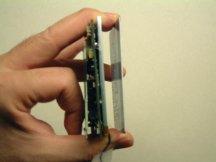In DoCoMo's video from
"NTT DoCoMo: VISION 2010" you can see a person using a credit card sized device that communicates wirelessly (from within a few feet) with a POS. The person (an elderly lady impersonating a consumer, pays for her purchase with this device, selecting the form of payment from the device, presumably while using some security feature (a PIN? a fingerprint?), without the need to type or enter anything into the POS, or give the cashier a card.

Interesting but if you want it "now" check the following picture (circa 2003). It has WLAN, battery, display, buttons and it is credit card sized, albeit a bit thicker (~14mm) since it was built with off-the-self components. It will scan for available Points of Sale (a POS is accessible through a Access Point or it has a AP attached to it) , connect to the one that the consumer chooses and the consumer can make a payment (the whole wireless environment is "open" at the transport layer). A payment takes less than 15 seconds (the consumer types a PIN; security does not rely on the PIN only, of course).

The whole concept will work with a WLAN-capable mobile too.


